An Introduction to Automation Testing

Automation testing has become a key part of software development process in most organizations across the globe today. There are several advantages of automation testing and it is experiencing rapid advancements in technology with every passing day. Today, there are several new age test automation tools that have made it easy for organizations to implement automation testing with effective results. In fact, it is fast replacing manual testing as the most widely used method of software testing.
Moreover, there are several test case scenarios that are possible only with the help of automation. Here we shall have an overview of automation testing and in the subsequent blogs in the Automation Testing series, we shall be focusing on each of its key aspects. So, let’s get started.
Why Choose Automation Testing?
Automation testing refers to testing a software or an application with the help of tools, scripts and software instead of humans testing them manually. Automation testing compares the results of testing with the expected results. It is preferred over manual testing as automation can be used to execute repetitive tasks with ease as well as additional test case executions.
There are several benefits of automation testing that have contributed to its popularity and a few of them are given below:
- Brings about a substantial increase in testing efficiency
- Performs test steps precisely every time with no scope for errors
- Executes more number of tests for a particular software to improve the test coverage.
- Saves time and costs to contribute towards a higher ROI
- Offers unmatched volume and simultaneity
- Makes it possible to detect bugs during the early stages of the software life cycle
However, it must be noted that in spite of the many benefits that automation testing offers over manual testing, there are still test case scenarios where manual testing is a necessity.
The Automation Testing Process
The automation testing process includes several steps, such as defining the scope of automation, choosing the right automation tool, writing & developing the test scripts, and execution of test cases, among others. Given below is the graphical representation of the process.

(Source: https://sreejithtesting.wordpress.com/test-automation/test-automation-process/)
So, the key steps in the automation testing process can be listed as follows:
- Decision to Automate the Testing Process
- Acquiring the test automation tool
- Planning, Design & Development
- Execution & Management
- Review & Assessment
Automation Testing with Selenium
There are several automation tools available in the market today but most of them are built using the Selenium framework. There are several reasons behind the growing popularity of Selenium and a few of them are given below:
- It is an open source freeware tool that calls for zero initial investment.
- It offers the support of a strong and active online community that posts frequent updates and also allows users to share their codes with the community.
- It is designed to run on multiple browsers and platforms which contributes towards a wider scope of automation.
- It offers unmatched flexibility as it supports a host of languages like PHP, Perl, Python, and Ruby, among others, even though it is built in Java.
- It offers flexibility when it comes to reporting tools and build systems as it integrates with Qmetry, Hudson, SauceLabs, and other popular tools
The Digital Group’s QARA Test is also an automation testing tool that is based on the Selenium framework and offers all the benefits of Selenium. It is a comprehensive zero coding test automation tool that supports in-depth reporting and analytics along with complete test management with JIRA integration.
To learn more about QARA Test, its features and benefits, visit http://www.qaratest.com/
Up Next on the Test Automation series: 7 Steps to Introduce Automation Testing in your Organization
Write a comment
- ashwini November 18, 2021, 10:21 amvery informative article. Thank you for sharing.reply
- William Hruska April 23, 2020, 11:01 amGreat post. Really helpful for automation testers. Keep up the good work.reply
- preetiagarwal April 11, 2019, 5:58 amGood Post. I like your blog. Thanks for Sharing--reply
- Depart1 April 29, 2020, 5:12 amNice blog, very interesting to readreply
- misha March 8, 2019, 7:50 amGreat blog !! great bulk information available in this blog this blog are very helpful for software testing freshers like me, thank you.reply
- preetiagarwal February 14, 2019, 10:52 amThanks for sharing blog with us on Introduction to Automation Testingreply
- Techclouderp September 10, 2018, 9:15 amNice blog, very interesting to readreply
